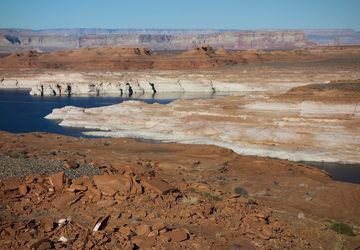About two and a half hours northeast of Sacramento, there’s a little town called Graeagle (pronounced “Gray Eagle”) nestled in the Sierras of Plumas County, California. Running through it is the Feather River, the principal tributary of the Sacramento River. The area surrounding Graeagle – a region of the northern Sierra near the Feather River’s Middle Fork – is known to hikers and vacationers as Feather River country.
A friend of the Lane Center, Tom DeMund, ’57, first found himself in Feather River country in 1965, shortly after getting out of the Army. Entranced by its beauty – the pine-scented air, myriad bird species, incredible wildflowers and seemingly endless trails – DeMund fell in love with the area and vacationed in Graeagle for many years. In 1992, he and his family built a log cabin there which allowed them to spend hours each summer investigating the walks and hikes that DeMund eventually collected in a book known as the hiking book of the Northern Sierra. In fact, if you’re ever lucky enough to experience Feather River country, you will likely find yourself standing at a trailhead surrounded by fellow hikers leaning against their cars studying DeMund’s comprehensive guide. First published in 2001, “Feather River Country Adventure Trails” is now in its seventh edition. I caught up with DeMund while he vacationed in his Graeagle home to ask him about the latest version of this much-celebrated guidebook.
A Q&A with Tom Demund, author of “Feather River Country Adventure Trails: 104 Hikes within the Region of the Feather River Upper Middle Fork, the Lakes Basin, and the North Yuba River”
Answers have been edited and condensed for clarity.
Q: So nice to speak with you again, Tom, and congrats on the seventh edition of your book. Can you start by telling our readers how you discovered Feather River country in the first place?
A: After I got out of Stanford and out of the Army (I earned my first degree from Stanford in 1957 and my second in 1958), I joined a company that sold heavy electrical equipment – transformers, turbines and stuff like that. I worked in their sales department in San Francisco, and my territory was Northern California – all the little power companies other than PG&E. Well, there was a little company in a town called Portola that served the local region up here (Feather River country), and I used to come up and sell transformers to these people. And whenever I’d come up, we’d stay overnight and do a little hiking the next day. So I found out by being here on business just how nice the area was. From there, we started coming back again and again. I mean, you can’t write a hiking book about a place and not be up there all the time!
Q: At that time, were there any other hiking books about the area that you knew of?
A: No, there weren’t. In fact, there was there was an old, old map that was sold at local stores. And I thought I’d do a new map with the new trails on it. But once I started thinking about that project, I thought, heck, instead of a map, maybe I’ll just do a whole hiking book!
I first published the book in 2001. However, I spent three years prior to that hiking trails and doing trail research. My first edition had 100 trails, but I actually hiked 120 trails in the previous three years. With each new edition I've discarded several hikes that I felt were not of particular interest or had "flaws" (such as a new “No Trespassing” sign that hadn't been there before, or a change in the directions on how to get to the trailhead) and added several new ones that I'd discovered since the previous edition was published.
Last summer, in preparation for this seventh edition, I hiked 67 different trails all summer long. I made trail notes of all the things that had changed. It’s amazing the number of changes from the sixth to the seventh edition.
Q: Is it busier up in Feather River country right now because of COVID-19? Are there more people than usual?
A: This summer the trails are delightfully full of hikers. Evidently a lot of Bay Area (and Sacramento and Reno) folks decided not to fly to Paris for vacation this year and, instead, drove to Graeagle where masks are not required on the trail and the air is fresh and virus-free (we hope).
Q: Do you have a favorite hike in the book?
A: My very favorite is the Gray Eagle Creek Dam and Penstock Trail, a trail that I actually created myself. A penstock is a big water pipe that’s used to feed water into a hydraulic turbine. There’s a dam up on Gray Eagle Creek here that feeds water downhill in this big pipe to a turbine and creates “free” energy. So in the original edition of the book I wanted to hike up to the dam and have that as one of the hikes. There was an old road that went up to the dam, but it was rocky, and roads aren’t really good hiking trails as a rule. As I was hiking along one day, I looked down and saw part of the pipe – the penstock – sticking out of the ground way down below where the road was. And I thought well, if they put that in, the workers must have had machinery down there and a route that they followed to install it. So I went down to look at where the penstock was, and lo and behold, I figured this could be a really nice trail following along where the pipe had gone between dam and powerhouse.
The pipe had grown over with Manzanita bushes and other vegetation. So I spent one whole summer recreating that trail, cutting back the Manzanita and overgrowth. It’s my favorite because I created it! It’s close to town and not too steep and it’s fun because the piping is buried in a lot of places. In some places you can see the very top of the penstock sticking out of the ground. When I hike it with kids I have them count how many times they can see the pipe sticking out of the ground.
Q: What's new in the seventh edition?
A: The book is kind of designed for all the families who want to experience the wilderness and outdoors and do some hiking. So in this edition, I took some of the longer hikes – the 11- and 12-milers that families with little kids wouldn’t want to do – and either discarded them or converted them to shorter ones that were one, two and three miles in length. So families could do them. It’s a great way to get kids involved in the wilderness and enjoying nature. There’s no better way to do this than hiking down a trail.
Q: Where can we buy a copy of the book?
A: Well, I’ve sold 17,000 copies through local merchants up here in Feather River country. And I want to continue supporting the local merchants, so I don’t have a website or sell it online or anything. If people want to buy copy, they should just tomdemund [at] aol.com (subject: Book%20Purchase) (email me) and I’d be happy to mail them one.
Q: Anything else you’d like to add about the book, Tom?
A: The trails in this area are very safe, particularly for families. I’ve been hiking the area for 30 years and have never ever seen a mountain lion on any of the trails. They are around, but they are afraid of people. I usually see a bear about once a summer, but they turn and run the minute they see you. Rattle snakes – in all these years I’ve only seen one, and that was on a trail that’s not even in my book. So the area is extremely safe for people to be in. The only thing people have to worry about is the occasional thunderstorm that happens a couple of times a summer in the afternoon!
Another thing is these hikes have moderate elevations. It’s not like the High Sierras. The elevations here are around 8,000 feet at the top of the peak. Our cabin is at 4,300 feet. People who get altitude sickness don’t get it here. People with heart problems probably have an easier time here than in Tahoe.
And a final thing that’s useful about the book is that most of the trails are fairly easy to navigate. I have yet to have anybody tell me that they’ve gotten lost while hiking a trail in my book.
Happy trails to our entire Bill Lane Center community - we hope you discover some new favorite hikes in Tom DeMund's excellent guidebook. tomdemund [at] aol.com (subject: Book%20Purchase) (Email Tom) directly to purchase your book today.




